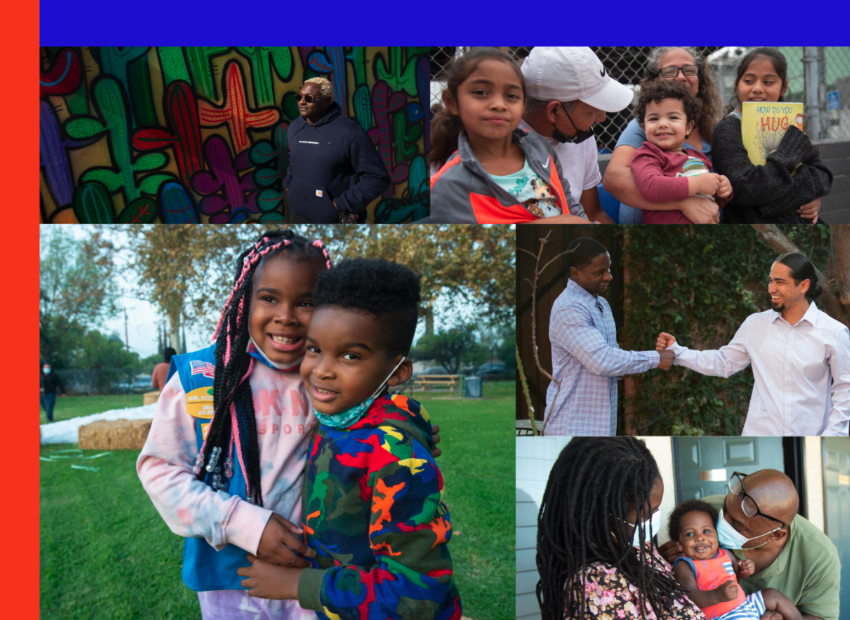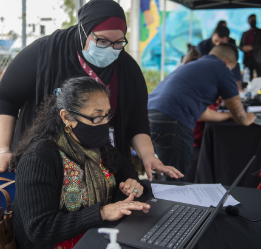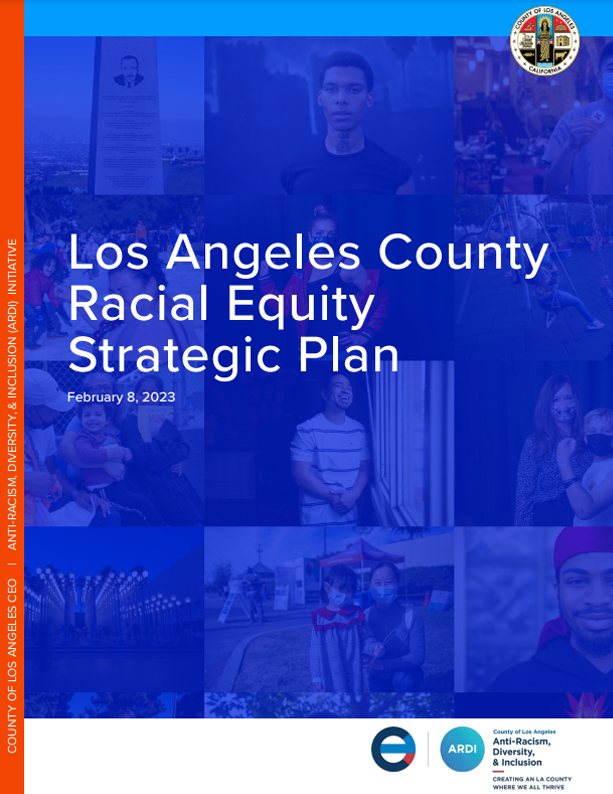The LA County Racial
Equity Strategic
Planning Process
On July 21, 2020, the County of Los Angeles Board of Supervisors (Board) adopted a sweeping initiative that boldly articulates an antiracist agenda that will guide, govern and increase the County’s ongoing commitment to fighting racism in all its dimensions, especially racism that systemically and systematically affects Black residents. The unanimously approved initiative includes an eighth Board-directed priority to address the elimination of racism and bias in the County through the development of a Strategic Plan led by the Anti-Racism, Diversity, and Inclusion (ARDI) Initiative.
The Los Angeles County Racial Equity Strategic Plan sets a shared vision for racial equity in the County, with a clear roadmap for how County departments, community stakeholders and partners can work collectively to measure and track progress along the way.

The process to develop the Racial
Equity Strategic Plan consists of
six (6) phases with multiple steps:
During this phase, we determined our shared mission, vision, and values for the Strategic Plan. Phase 1 also consisted of establishing Countywide equity principles to guide the plan’s development and align County priorities, programs, and policies with Board approved equity goals. During Phase 1, we also determined our North Star Life Course Outcomes which identify which population-level changes we seek to achieve through our racial equity actions and initiatives. The criteria used in the selection of the Life Course Outcomes included their focus on an area of concern (i.e., physical and mental health, housing, education, employment, economic mobility, public safety, and justice) listed in the Board Motion that created ARDI; showing large racial gaps; having a high prevalence in the population (affects a relatively large number of people); having high leverage (potential to improve other important outcomes); and having low redundancy (another potential outcome is not primarily responsible for its long-term effects).
Contributing outcomes are the institutional, policy, and ecological factors that influence our priority Life Course Outcomes. Our contributing outcomes were compiled from empirical studies (studies that use quantitative analysis of survey or administrative data); multivariate designs (studies that use statistical techniques like regression to control for other variables when identifying the relationship between a contributing outcome and the North Star outcome); studies that included samples that are representative of the whole nation, with samples of California or LA County preferred; longitudinal studies; cross-sectional studies; intervention studies (studies using randomized controlled trial or quasi-experimental designs that show changing a potential contributing factor ultimately changes a North Star Outcome); studies with sample characteristics of 400 or more respondents and which includes Black, American Indian, Latino or Pacific Islander in the study sample; administrative data (multivariate analysis of administrative data); and expert opinions (experts and practitioners working in front-line systems could also provide informative insights on critical contributing outcomes).
During this phase, we also identified the County’s change levers to influence Life Course Outcomes and related factors through a Zone of Authority analysis (change levers that fall within the County’s or Department’s jurisdictional boundaries) and mapping of the County’s Sphere of Influence (stakeholders and their change levers that lie outside the Department’s or the County’s zone of authority, but to which the County or Department has a formal or informal influence relationship).
We determined which indicators will align with the Life Course Outcomes and identified the goal targets that should apply across departments and/or which indicators will help departments track outcomes. These metrics and goal targets will help hold us accountable for meeting our Life Course Outcomes and support the County in tracking progress.
This phase also identified new initiatives (e.g., programs, policy changes, cross-department efforts) that can plausibly close racial disparities and develop timelines for implementation. The crafting of strategy statements for these new initiatives needed to be specific (distinct vs. vague or general idea); feasible (possible to achieve over the next few years); impactful (will likely have a significant impact on the outcome of interest); and compelling (bold enough to generate enthusiasm and support). We prioritized new initiatives based on our assessment of change levers, feasibility, and alignment with our guiding equity principles. Phase 4 also entailed defining potential points of alignment across initiatives and departments and developing joint initiatives across departments, if and where appropriate.
During Phase 5, departments are expected to develop Racial Equity Action Plans, or implementation plans, to prioritize actions, strategies, and programs that operationalize the Strategic Plan and achieve progress towards the Plan’s target goals and outcomes.
Phase 6 involves Plan implementation, where departments are expected to execute the Racial Equity Action Plans and utilize the metrics and target outcomes to measure progress along the way.

Racial Equity Strategic Plan Progress
During an 8-month planning process between July 2021 and May 2022, staff from 29 County departments participated in 25 planning workshops to implement these steps. The recommendations that emerged from this process were reviewed by the ARDI Community Input Advisory Board (CIAB) and other community stakeholders.
How did we create the Strategic Plan and what framework did we use?
Informed by “A Life Course Framework for Improving the Lives of Disadvantaged Populations,” the planning process was oriented to taking “the long view” and seeking to influence changes in population outcomes over the next several years.
Additionally, the Countywide Racial Equity Strategic Plan (RESP) was developed through a series of internal and external workshops with participants from 29 County departments in 25 planning workshops, as well as a series of input sessions to gather feedback from community-based organizations, residents, civic leaders, and the County workforce. Stakeholder and community member involvement were prioritized and integrated throughout the entire planning process to inform the final plan’s development.
While ARDI’s stakeholder engagement activities focused on the strategic planning process and the final plan’s development, ARDI will continue to engage, seek consultation from, and partner with, internal and external stakeholders as the County embarks on implementing the plan and other equity related initiatives.
Focusing on specific “life course outcomes,” the six-step planning and implementation process:
1
Identified key long-term population outcomes to influence, called “Strategic Goals,” as well as “Equity Principles” to guide the strategic planning effort;
2
Identified how to measure those outcomes;
3
Examined trends in those outcomes over time and set goal targets for changing those outcomes;
4
Identified major contributing factors that put people “on-track” or “off-track” to achieving the desired outcomes in the long-run;
5
Mapped the limits of county authority and the potential for collaborative partnerships; and
6
Identified strategic initiatives—ranging from programs to policies—to influence those contributing factors over the next decade.
Community and Stakeholder Engagement
The Countywide Racial Equity Strategic Plan (RESP) was developed through a series of internal and external workshops with participants from 29 County departments, as well as a series of input sessions to gather feedback from community-based organizations, residents, civic leaders, and the County workforce. Stakeholder and community member involvement were prioritized and integrated throughout the entire planning process to inform the final plan’s development. Channels for input from external stakeholders included:
The ARDI Community Input Advisory Board (CIAB), a diverse cross-sector group of community leaders, who provided consultation and input on the recommendations developed.
In total, 51 events took place with more than 1,300 participants in attendance. ARDI has since incorporated the feedback from these many stakeholder engagements into the plan, which significantly informed the direction of the ARDI Initiative.
While ARDI’s stakeholder engagement activities focused on the strategic planning process and the final plan’s development, ARDI will continue to engage, seek consultation from, and partner with, internal and external stakeholders as the County embarks on implementing the plan and other equity related initiatives.

Who Was Involved Strategic Plan Process

County Departments
The Racial Equity Strategic Planning process is also supported through the leadership of four dynamic workgroups that include staff from departments across the County. These Countywide workgroups are focused on advancing racial equity within the County, as well as within their respective departments. Department representatives from each workgroup engage their respective departmental colleagues, share workgroup updates, and bring back their departments’ feedback to inform the broader strategic plan effort. Each department will also develop Equity Action Plans aligned with the Racial Equity Strategic Plan priorities. ARDI provides guidance for Equity Action Team (EAT) members to ensure departments’ Equity Action Plans align with broader department goals. Executive Team Leads will work closely with department staff to help ensure there is cohesive integration, communication, and alignment with existing and ongoing initiatives within each department.

Residents and Community Partners
ARDI facilitated a series of listening sessions with community partners throughout the County, holding at least two sessions in each Supervisorial District with targeted outreach to youth, non-geographically concentrated populations, and people with lived experience. Furthermore, we work closely with our local cities, school districts, and regional agencies throughout our robust community engagement process to better coordinate and collaborate on our collective racial equity efforts.

Community Input Advisory Board
The Community Input Advisory Board (Advisory Board) convenes a broad spectrum of community leaders to provide consultation, critical thinking, and input on the direction of the strategic planning process, the draft plan, and emerging ARDI priorities. The Advisory Board is comprised of more than 20 community leaders, who represent community-based organizations, youth, philanthropy, academia, and resident-led organizations.

Planning and Data Workgroup
This group consists of representatives from various County departments who solicit input from their department colleagues, members of their department’s Equity Action Teams, and other key staff to inform the strategic plan goals and outcomes. While the Planning and Data Workgroup, along with the Community Input Advisory Board, guide much of the strategic planning efforts, the Los Angeles County Board of Supervisors makes all final decisions.
Racial Equity
Strategic Plan
The strategic plan articulates how LA County became inequitable, the historical factors that helped produce racial disparities, and presents a vision for a new reality in the County. Click the button below to download the full Los Angeles County Racial Equity Strategic Plan.


